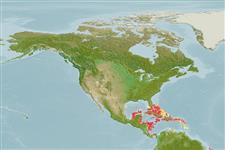Common names from other countries
Classification / Names / Names
Nomes comuns | Sinónimos | Catalog of Fishes (gen., sp.) | ITIS | CoL | WoRMS
Environment: milieu / climate zone / depth range / distribution range
Ecologia
; intervalo de profundidade 1 - 27 m (Ref. 86733). Tropical
Western Central Atlantic: Belize and Bahamas.
Length at first maturity / Tamanho / Peso / Idade
Maturity: Lm ? range ? - ? cm
Minimum depth from Ref. 87027. Only herbivorous amphipod known to feed only on and creates a domicile out of a few closely related seaweeds which produce dictyol-class diterpenes, a compund that prevents it from being eaten by reef fishes (Ref. 86733).
Life cycle and mating behavior
Maturidade | Reprodução | Desova | Ovos | Fecundidade | Larvas
Members of the order Amphipoda are gonochoric and sexually dimoprhic (males larger than females). Mating behavior: Males locate potential partners with the aid of their antenna to detect the pheromones released by the females; the male then rides or carries the female until the latter is ready to molt. When the female is ready, the male pushes the sperm into the marsupium and releases the female afterwards. A few hours later, the female releases her eggs into the marsupium for fertilization. Life cycle: Eggs are brooded in the marsupium. Eggs hatch into juveniles and remain in the marsupium for a few days. Each species undergo 20 molts at most, i.e., 1-year long life cycle.
Hay, M.E., J.E. Duffy and W. Fenical. 1990. (Ref. 86733)
Categoria na Lista Vermelha da IUCN (Ref. 130435: Version 2024-1)
Categoria CITES (Ref. 108899)
Not Evaluated
Not Evaluated
Ameaça para o homem
Harmless
Utilização humana
| FishSource |
Ferramentas
Mais informação
Nomes comunsSinónimosPredadoresReproduçãoMaturidadeDesovaFecundidadeOvosDesenvolvimento dos ovos
Idade/Tamanho
Crescimento
Comprimento-peso
Comprimento-comprimento
Morfologia
Larvas
Abundância
Fontes da internet
Estimates based on models
Preferred temperature
(Ref.
115969): 26.7 - 28.2, mean 27.7 (based on 366 cells).
